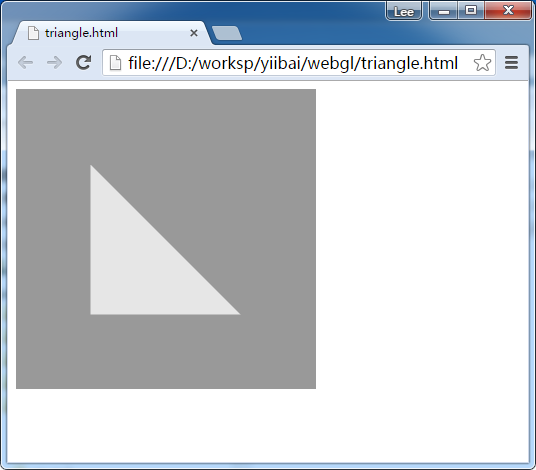WebGL繪製三角形
在前面的章節,我們討論了如何使用WebGL繪製三個點。並使用範例應用程式來演示如何畫一個三角形。在這兩個例子中,我們繪製僅僅使用頂點圖元。
繪製更複雜的形狀/網格,我們通過一個幾何圖形索引也一樣,如:頂點,向著色器。在本章中,我們將學習如何使用索引來畫一個三角形。
繪製三角形所需的步驟
下面的步驟是用來建立一個WebGL的應用程式以繪製一個三角形。
第1步 - 準備Canvas和獲取WebGL的渲染上下文
在此步驟中,我們使用的getContext()得到WebGL的渲染上下文物件。
第2步 - 定義幾何並將其儲存在緩衝區物件
由於我們使用的索引畫一個三角形,我們必須通過三角形的三個頂點,包括索引,並把它們儲存在緩衝器。
var vertices = [ -0.5,0.5,0.0, -0.5,-0.5,0.0, 0.5,-0.5,0.0, ]; indices = [0,1,2];
第3步 - 建立和編譯著色器程式
在這一步中,需要寫頂點著色器和片段著色器程式,編譯它們,並通過連線這兩個程式將建立一個合併程式。
-
頂點著色器 - 在程式的頂點著色器,我們定義向量屬性來儲存三維坐標,並指定為 gl_position。
var vertCode =
'attribute vec3 coordinates;' +
'void main(void) {' +
' gl_Position = vec4(coordinates, 1.0);' +
'}';
-
片段著色器 - 在片段著色器,我們只分配碎片顏色到gl_FragColor變數。
var fragCode = 'void main(void) {' +
' gl_FragColor = vec4(1, 0.5, 0.0, 1);' +
'}';
第4步 - 關聯著色器程式到緩衝區物件
在這一步,我們關聯緩衝器物件和著色器程式。
第5步 - 繪製所需的物件
由於我們使用的索引畫一個三角形,我們將使用drawElements()。對於這個方法,必須傳遞索引的數量。indices.length的值表示索引的數量。
gl.drawElements(gl.TRIANGLES, indices.length, gl.UNSIGNED_SHORT,0);
範例 - 繪製一個三角形
以下程式程式碼顯示了如何使用的索引來在WebGL中繪製的一個三角形 -
<!doctype html>
<html>
<body>
<canvas width = "300" height = "300" id = "my_Canvas"></canvas>
<script>
/*============== Creating a canvas ====================*/
var canvas = document.getElementById('my_Canvas');
gl = canvas.getContext('experimental-webgl');
/*======== Defining and storing the geometry ===========*/
var vertices = [
-0.5,0.5,0.0,
-0.5,-0.5,0.0,
0.5,-0.5,0.0,
];
indices = [0,1,2];
// Create an empty buffer object to store vertex buffer
var vertex_buffer = gl.createBuffer();
// Bind appropriate array buffer to it
gl.bindBuffer(gl.ARRAY_BUFFER, vertex_buffer);
// Pass the vertex data to the buffer
gl.bufferData(gl.ARRAY_BUFFER, new Float32Array(vertices), gl.STATIC_DRAW);
// Unbind the buffer
gl.bindBuffer(gl.ARRAY_BUFFER, null);
// Create an empty buffer object to store Index buffer
var Index_Buffer = gl.createBuffer();
// Bind appropriate array buffer to it
gl.bindBuffer(gl.ELEMENT_ARRAY_BUFFER, Index_Buffer);
// Pass the vertex data to the buffer
gl.bufferData(gl.ELEMENT_ARRAY_BUFFER, new Uint16Array(indices), gl.STATIC_DRAW);
// Unbind the buffer
gl.bindBuffer(gl.ELEMENT_ARRAY_BUFFER, null);
/*================ Shaders ====================*/
// Vertex shader source code
var vertCode =
'attribute vec3 coordinates;' +
'void main(void) {' +
' gl_Position = vec4(coordinates, 1.0);' +
'}';
// Create a vertex shader object
var vertShader = gl.createShader(gl.VERTEX_SHADER);
// Attach vertex shader source code
gl.shaderSource(vertShader, vertCode);
// Compile the vertex shader
gl.compileShader(vertShader);
//fragment shader source code
var fragCode =
'void main(void) {' +
' gl_FragColor = vec4(0.0, 0.0, 0.0, 0.1);' +
'}';
// Create fragment shader object
var fragShader = gl.createShader(gl.FRAGMENT_SHADER);
// Attach fragment shader source code
gl.shaderSource(fragShader, fragCode);
// Compile the fragmentt shader
gl.compileShader(fragShader);
// Create a shader program object to store
// the combined shader program
var shaderProgram = gl.createProgram();
// Attach a vertex shader
gl.attachShader(shaderProgram, vertShader);
// Attach a fragment shader
gl.attachShader(shaderProgram, fragShader);
// Link both the programs
gl.linkProgram(shaderProgram);
// Use the combined shader program object
gl.useProgram(shaderProgram);
/*======= Associating shaders to buffer objects =======*/
// Bind vertex buffer object
gl.bindBuffer(gl.ARRAY_BUFFER, vertex_buffer);
// Bind index buffer object
gl.bindBuffer(gl.ELEMENT_ARRAY_BUFFER, Index_Buffer);
// Get the attribute location
var coord = gl.getAttribLocation(shaderProgram, "coordinates");
// Tutorials an attribute to the currently bound VBO
gl.vertexAttribTutorialser(coord, 3, gl.FLOAT, false, 0, 0);
// Enable the attribute
gl.enableVertexAttribArray(coord);
/*=========Drawing the triangle===========*/
// Clear the canvas
gl.clearColor(0.5, 0.5, 0.5, 0.9);
// Enable the depth test
gl.enable(gl.DEPTH_TEST);
// Clear the color buffer bit
gl.clear(gl.COLOR_BUFFER_BIT);
// Set the view port
gl.viewport(0,0,canvas.width,canvas.height);
// Draw the triangle
gl.drawElements(gl.TRIANGLES, indices.length, gl.UNSIGNED_SHORT,0);
</script>
</body>
</html>
這將產生以下結果 -

